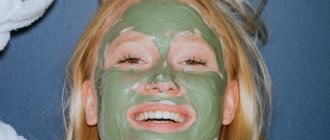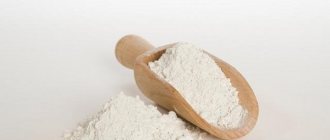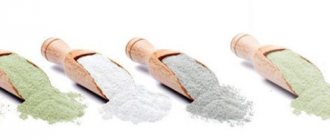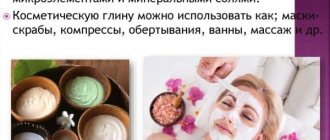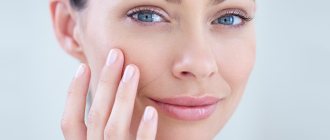Updated: 06.22.2021 Cosmetic clay masks are again at the peak of popularity, and deservedly so. Clay is a unique natural substance that is rich in calcium, magnesium, iron, nitrogen, potassium and other trace elements, as well as mineral salts.
The unique properties are due to the specific structure of the substance - it consists of a large number of small plates superimposed on each other, like tiles on a roof. It turns out that the clay particles are small in size, but have a large surface area. Therefore, they adsorb dirt and excess sebum well, tighten pores, stimulate blood flow to the upper layers of the epidermis and accelerate cell renewal.
There are several varieties of clay that are widely used in cosmetology, as their effectiveness is not inferior to expensive products. Each type of clay has its own characteristics, let’s look at the main ones.
- Blue clay.
Suitable for oily and combination skin, it has smoothing and softening effects, helps in the fight against acne, and relieves inflammation. - White clay.
Penetrates deeply into the layers of the epidermis, evening out the complexion and eliminating small wrinkles. White clay masks effectively cleanse impurities and dry out oily skin. Due to its strong drying effect, it is not recommended for dry skin. - Yellow clay.
Cleanses the skin well, tightens the oval of the face, and is able to remove toxins. - Pink clay.
Suitable for sensitive skin, eliminates inflammation, redness and small wrinkles, maintains elasticity, and has a softening effect. The pink color is achieved by mixing white and red types of clay. - Green clay.
Optimizes the functioning of the sebaceous glands, eliminates inflammation and flaking, nourishes and tones the skin, and reduces pores. - Black clay.
Improves blood circulation and metabolism in cells, suitable for oily and dry (combination) skin. The mask evens out the complexion and has a mattifying effect.
We present the rating of face clays 2022. The best 12 products that were selected by our experts based on user reviews and ratings.
| Rating (2021) | Prices, ₽ | A country |
| 1. DNC White | from 60₽ | Russia |
| 2. Fito cosmetics blue Cambrian | from 30₽ | Russia |
| 3. Medicomed Blue cosmetic | from 35₽ | Russia |
| 4. Folk recipes black Kamchatka volcanic cleansing | from 90₽ | Russia |
| 5. Fito cosmetics pink Egyptian moisturizing | from 40₽ | Russia |
| 6. Goat Dereza Black Kamchatka | from 120₽ | Russia |
| 7. DNC Green | from 60₽ | Russia |
| 8. BioAqua cleansing oxygen bubble based on clay | from 230₽ | China |
| 9. L'Oreal Paris Magic Clay Detox and radiance | from 180₽ | France |
| 10. Eunyul Clean & Fresh to improve skin elasticity | from 115₽ | South Korea |
| 11. DerMeiren Wash off Pore Tightening Mud Mask | from 110₽ | South Korea |
| 12. Cafe mimi Clear skin Blue clay and Sage | from 140₽ | Russia |
Which facial clay is best to buy?
As can be seen from the rating, clay masks can solve various problems with facial skin. Manufacturers offer both pure clay powder, from which you need to make a mixture yourself, and ready-made masks for skin care. These products are quite effective, and most importantly, the result is almost always noticeable after the first use.
The cost is suitable for any consumer - masks are presented in different price segments. Some products can be used not only for the skin of the face, they are also applied to the hair or body - clay promotes healthy skin, has a rejuvenating effect, and strengthens hair. Let's pay attention to some criteria that should be taken into account before purchasing.
- Skin type.
This is the main indicator when choosing clay. Those with dry skin should be especially careful, as masks have a drying effect. However, manufacturers supplement the composition with moisturizing and nourishing components to avoid tightness. It is possible to use different types of clay on different areas of the skin, for example, one type of clay is applied to the T-zone, and a mask with a more gentle effect is applied to drier and more sensitive areas. - Compound.
It all depends on the needs of your skin. Does she need a combined effect or is a clay mask in its pure form sufficient? - Mode of application.
Are you ready to create a mask with your own hands or is it more convenient for you when it is presented in finished form? Any option is suitable for home use, but for trips and trips it is better to purchase a ready-made product that you simply apply to the skin. - Packaging parameters
. Please note that clay in powder form is additionally diluted with water. Therefore, the package will yield at least twice as much product ready for application. Manufacturers offer clay in packages of different sizes, some are convenient for use at home, while others will become indispensable travel companions. If the package is intended for more than one use, consider whether the printed product can be tightly sealed. - Manufacturer.
Of course, it is better to contact trusted manufacturers and buy products in specialized stores. This way you can be sure that you have not purchased a fake, but a really good and effective product.
We hope our rating has expanded your knowledge about clay masks and you were able to choose the best product for your skin. Successful purchase and effective results!
Thanks to All.ru in Yandex Zen. Daily updates, subscribe, we have a lot of interesting things
Rules for preparing a mask
- When making the mixture, do not use metal utensils. It enters into a chemical reaction with the substance. Because of this, the mask becomes unsuitable for application. The spatula or spoon used to spread and apply the mask should also not be metal. It is better to use materials such as glass and ceramics.
To avoid lumps while preparing the mask, slowly pour water into the powder, and not vice versa.
- Before the procedure, you must thoroughly cleanse the skin. It is better to apply the mask to slightly damp facial skin while lying down so that the skin is not pulled down due to the weight of the mask. Do not apply the mask to the areas around the eyes, mouth and eyebrows, as... clay can dry them out. Do not use scrubs or peels before a cosmetic procedure. No need to steam your face. The mask will be effective even if it is not applied to the entire face. It is permissible to lubricate only problem areas, for example, the forehead or chin, or even individual pimples that you want to dry out quickly. This is especially true for those with combination skin.
- The mask dries the skin very much, so you should keep it on oily skin for no more than 15 minutes. Those with normal to dry skin have even less.
- During the procedure you need to relax. Do not strain your facial muscles, try not to even talk. Otherwise, the effect of the mask will decrease. And when the mixture begins to dry out on the face, any muscle movement will cause discomfort.
- Never wait until the mask is completely dry before removing it from your face. On the contrary, if you see that certain areas have dried out ahead of time, splash water on your face or apply a damp towel. Otherwise, instead of benefit, the skin will be harmed. Because when clay dries, it greatly tightens the skin.
- Remove the mask from your face after first wetting your face with water. Then gradually rinse with warm or cool water. Do not remove the mask when dry.
- When washing, you can gently massage your face, and the clay will act as a scrub. Afterwards, pat your face dry with a towel; do not rub it too hard.
- After this, be sure to use a toner, then a moisturizer to avoid the skin feeling as if it is tight.
- Cosmetologists do not give recommendations on what time of day is best to make a mask. Therefore, you can do the procedure in the morning before applying makeup or in the evening after removing it.
- To cope with oily skin imperfections, it is better to make a mask 2 times a week. Depending on the condition of the skin, some people make a mask every other day. Monitor your body's reaction when deciding how often to make masks. Noticeable changes will appear within a month. When the desired result is achieved, you can maintain it by using a mask once a week. Types of clay can be alternated.
Do not make the mask mixture several times at once, do not store it in the refrigerator or other places. Use as many ingredients as needed for one time, and prepare the mask immediately before applying it to your face.
Cleansing composition
This mask whitens, tightens pores, removes purulent formations, and soothes inflammation. It is recommended to perform the procedure no more than 3 times a month in order to prevent the formation of age spots and wrinkles. To prepare the product you will need 10 g of cosmetic clay, a few drops of sage essential oil, 1 tablet of activated carbon. The sorbent should be steamed with a warm decoction, then mixed with gray clay and medicinal oil. Before applying the mask, the skin is steamed using a compress. The composition is applied with rubbing movements for 10-15 minutes. Clay is removed from the face with water mixed with grapefruit ether.
Terms of use
The most important rules are the following:
- Before preparing the mask, you must bring all ingredients to room temperature. This means that you should not take them out of the freezer or heat them in a water bath 10 minutes before mixing.
- During the process of mixing the components, you need to monitor the mixture and immediately eliminate all lumps.
- It is necessary to wash off the product from the face after it has dried. It is best not to wait until the applied layer begins to crack, as this will damage the surface of the leather.
- If the resulting mixture is too thick and dries quickly on the face, you can first spray the surface to be treated with thermal water.
- Remove the composition from the face only with running water. Thermal liquid or tonic is not suitable for this purpose. Moreover, it is necessary to wash thoroughly so as not to leave any particles.
- If the mask is applied for the first time in your entire life, you must first test it for skin sensitivity. To do this, you will need to apply a small amount of the resulting composition to the bend of your elbow and observe the reaction for 10 minutes. If no changes occur, then the mask can be safely used.
- After washing, you only need to wipe your face with a soft towel and smooth circular movements. But under no circumstances should you press or rub the skin.
How to choose cosmetic clay for dry skin: which one is suitable
The varieties of cosmetic clay presented on store shelves differ not only in color, but also in the effect they have on the skin of the face. So, for oily or combination skin types, masks with a drying effect are suitable, while for dry skin such products are strictly contraindicated by cosmetologists. For sensitive epidermis, clay with a matting effect is recommended to be used exclusively in diluted form. Therefore, you need to choose the right clay for your skin type, otherwise it may cause irritation or have the opposite effect.
To do this, add to the masks:
- nourishing oils;
- herbal decoctions;
- chopped fruits;
- dairy products;
- honey;
- egg yolk.
Pink and red clays provide the most gentle care for dry skin. Both types are distinguished by their delicate consistency, due to which the delicate removal of keratinized epithelial cells occurs.
Pink clay has a regenerating effect, increases blood flow in the tissues of the skin, thereby saturating the skin with essential nutrients and oxygen.
White, green and blue cosmetic clays can be applied in diluted form. Such products affect the production of the sebaceous glands, thereby reducing the amount of sebum secreted.
On oily or combination skin types, products with a similar effect work much better than on dry, flaky skin. That is why, before using clay with a drying effect, it is additionally diluted with various natural ingredients or oils. You can find out which facial clay is the most effective here.
When giving preference to one type or another, do not forget to take into account two important factors:
- Clay deposit. The area where the rock was mined must comply with environmental standards. Only clay that does not contain harmful toxic substances and heavy metals will be useful.
- Composition of the product. Some manufacturers make the mistake of producing low-quality clay, giving the powder the desired shade using various chemical dyes. Such products not only cause harm, but also stain the skin, after which it is necessary to cleanse the face in other additional ways.
Pay special attention to the composition of the clay from which you make cosmetics.
White
White clay, or, as it is also called, kaolin, is used primarily in the care of oily skin. Dry bluish or yellow powder is mixed with a small amount of water to obtain a plastic, creamy consistency.
White clay has a beneficial effect on mature skin. Homemade masks based on kaolin and nourishing oils well moisturize the epidermis, thereby helping to smooth out fine expression wrinkles. The whitening effect of white clay allows you to get rid of age spots in the shortest possible time, and the rich silicon content promotes increased collagen production in the upper layers of the dermis.
White clay cleanses pores of impurities, relieves inflammation, and effectively whitens red spots after acne.
Clay masks should not be left on dry facial skin until completely dry. Otherwise, the mask will take all the moisture from the epithelium and dry out sensitive skin even more. To prevent the clay from hardening during the procedure, periodically spray your face with thermal water or any hydrosol.
Red
The soft texture of the mask is very gentle on dry skin. Red clay perfectly relieves redness, eliminates itching, flaking and gives the face a healthy, radiant appearance. The powder contains a large amount of copper and iron, which have an intense restorative effect.
Unlike other types, red clay does not dry out the sensitive epidermis, which is prone to flaking.
Red clay perfectly cleanses accumulated impurities, removes dead cells and has a pronounced antiseptic effect.
Pink
It is obtained by mixing white and red clay. These masks effectively fight the first signs of aging thanks to the rich content of kaolinite, illite and calcium. You can learn about the properties and uses of pink clay in this material.
A successful combination of two powders is used as a delicate scrub. Clay peeling cleanses clogged pores, thereby eliminating problematic skin from comedones, blackheads, and various skin rashes.
Masks based on pink clay tone the skin well and affect blood flow in the upper layers.
Green
It affects very deep layers of the dermis, resulting in thorough cleansing of the skin. Green clay is very popular in cosmetology. You can learn more about the properties and uses of green clay here.
Green clay masks demonstrate several effects at once:
- tighten aging mature skin;
- intensively nourish dehydrated epidermal cells;
- have a tonic effect.
The healing properties of green clay allow you to restore the natural hydrolipid balance of the skin, nourish cells with useful substances and smooth out fine wrinkles.
Cosmetic clay should not be diluted in metal containers. During the mixing process, the metal reacts with the powder, which negatively affects the subsequent effect of the cosmetic procedure.
Gray
Based on gray clay, various masks and creams are produced that have a pronounced lifting effect. Systematic use of such products promotes skin rejuvenation, relieves puffiness and improves complexion. The delicate consistency of gray clay absolutely painlessly cleanses the skin of impurities, and the potassium and zinc contained in it help actively remove harmful toxins.
Despite this, gray clay has managed to gain popularity in the cosmetology industry due to its concentrated composition and effective anti-aging effect.
Gray clay is considered the rarest type, since the rock is mined at the bottom of the sea.
Yellow
It got its name due to the yellow tint of the rock, which was formed due to the presence of potassium and iron in the composition. These microelements have pronounced antioxidant properties and also remove toxic substances from epidermal cells.
Yellow clay is suitable not only for dry sensitive skin, but also for oily skin due to its bactericidal, antiseptic and wound-healing effects on the dermis. This product perfectly moisturizes dehydrated epithelial cells, and its pronounced regenerating properties help fight microcracks, peeling and redness of the skin. Find out about the properties and uses of yellow clay by following the link.
Yellow clay has a tonic effect.
Recommendations for use
As previously mentioned, clay does not cause allergies, so it can be used by everyone. But the masks contain various components. It may turn out that you are allergic to one of them. Therefore, carefully consider the composition of the mask before applying it to your own face. Make sure that you do not have an individual intolerance to any component of the recipe.
To do this, check the composition in the standard way. Apply the components to a small area of the elbow in advance. Leave on for half an hour, then rinse off. If no reaction is detected after a day, the mask can be used.
Remember that although masks with clay are effective, you should not limit yourself to them. Watch your diet and choose the right skincare products to reduce the appearance of oily shine and get rid of rashes.
Recipes
Even if the clay is simply diluted with water and the resulting mixture is applied to the face, it will benefit oily skin.
However, it would be foolish to ignore recipes that have already been tried by owners of oily skin and which they decided to share. As a result of preparing the mask according to any of the recipes, the result should be a fairly thick mass, with a consistency similar to sour cream. Initially, it is better to adhere to the volumes or ratios of parts indicated in the recipes. However, after 3-4 times you will decide how much volume of the mask is needed to cover the entire face, and you will also understand what consistency is most convenient. After this, you can determine by eye how much to add ingredients, only adhering to the required proportions.
In masks with a large number of constituent substances, it is best to adhere to the volumes indicated in the recipe so as not to harm the skin.
Drying
Since any clay dries out the skin, in this case you can use the classic version of the mask. To do this, you need to mix clay and boiled water in proportions of 1 to 1. The result should be a lump-free mixture. Adjust the consistency yourself. Sometimes a little more water may be needed. Instead of plain water, it is permissible to use an infusion of herbs. For example, string, sage, chamomile or oak bark.
The drying mask removes excess shine while moisturizing the skin.
Follow the general rules when applying a mask. After removing, be sure to use a moisturizer.
To remove shine
For this mask it is better to use white or green clay. Mix it with water. Add glycerin. On average, 5 g of glycerin is added per 100 g of clay.
Since glycerin absorbs moisture, that is, collects it from the environment, it is better not to use a mask if the air humidity is low. For example, in winter. Otherwise, glycerin will draw moisture from the skin of the face. And although the skin is oily, it needs hydration. Find another recipe for a mask with glycerin here.
Cleansing with talc
Instead of water, mix 1 part white, green or blue clay with 2 parts warm milk. Add 1 part talcum powder.
This mask will not only cleanse the skin, but also dry it.
Cleansing and tightening pores
For 1 tsp. white clay use a quarter tsp. carbonated magnesium, the same amount of borax and half a tsp. talc. Instead of water, fill the mixture with 3% hydrogen peroxide.
Apply the resulting paste to your face for 15 minutes, then rinse off.
For cleansing and mattifying
To prepare the mask, you need to mix 1.5 tbsp. white clay, the same amount of starch, 5 tbsp. magnesium carbonate, 1 tbsp. l. talc. Then add half a teaspoon each of boric acid powder and alum. Fill everything with 3% hydrogen peroxide until the desired consistency is formed.
Monitor the quantity yourself. If it turns out too much, reduce the volume of components used, maintaining the proportions. The most effective starch masks are here.
You cannot store the mask until next time, so you should carefully select the proportions.
For whitening with kaolin
For a whitening effect, use white or blue clay. Take 2 tbsp, add 1 tsp to them. liquid honey, 1 egg white and 2 drops of lemon juice. Pour in all 3 tbsp. boiled water. Stir until no lumps remain. Apply to face. Also read about other masks with lemon in the article.
For acne and inflammation with aloe
Mix the 3 main ingredients of the mask in the following proportions: 2 parts clay, 1 part water and 1 part juice. Apply the resulting aloe mask to your face, then rinse and use a moisturizer.
This mask regulates the functioning of the sebaceous glands, narrowing the pores.
Tonic with cucumber juice
It is advisable to use fresh cucumber juice. Therefore, it is most convenient to prepare a mask in the summer, when you have access to fresh vegetables.
To obtain a cosmetic mixture, add 1 part white clay and 1 part blue clay to 3 parts cucumber juice. Apply the mask and then rinse, following the general recommendations. The best cucumber masks are collected in this material.
Nourishing with kefir
Use 2 parts white or green clay. Dilute it with 2 parts water and 1 part kefir. Add a couple drops of lemon juice. If you make a mask in the summer, add a teaspoon of finely chopped parsley. The mask will become even more useful.
Apply and rinse as usual. Other kefir masks are presented at the link.
Whitening with moisturizing effect
If possible, you can use a rather exotic recipe that requires adding papaya pulp to the mask.
To prepare, mix 2 tbsp. l. pulp with 2 tsp. clay of any color, add 1 tsp. aloe juice Apply the finished mixture to your face and rinse after 15 minutes.
Whitening masks cope well with problematic skin pigmentation.
Properties and effect on the skin
Using clay significantly improves the condition of the outer layer of skin. The main advantage of this element is to cleanse and dry the epidermis. Masks prepared on its basis regulate excessive sebaceous and sweat secretions, remove impurities from pores, even out and refresh the complexion. In addition, the skin becomes more elastic and tightened.
Another benefit of clay is its exfoliating, anti-inflammatory, antibacterial and analgesic effects. During its use, an environment is created at the site of the lesion that is inconvenient for the life and development of pathogenic bacteria. Mineral substances suppress their development, which is especially important when purulent abscesses and ulcers occur. Clay relieves inflammation and soothes, so its use is recommended for sprains, burns and bruises. Masks made from this component also relieve itching and avoid irritation in sensitive areas.
To make the result more effective, it is necessary to dilute the clay masses with other natural ingredients: essential and cosmetic oils, herbs or decoctions prepared on their basis, chicken and quail eggs, fruits, berries, sour cream, gelatin.
Reviews from people
Oddly enough, there are only positive reviews about whitening clay. People who have used it several times already claim that the effect is simply amazing. For many of them, just a couple of sessions were enough to eliminate the hated age spots and even hide dark circles under the eyes.
Clay with a whitening effect is actively used by both women and men. They all got unexpected results and kept them for a long time. People are pleasantly surprised that just one procedure per week is enough to maintain good skin condition.
Product selection
Blue and white whitening clay has an excellent effect on the skin in the following way:
- eliminating post-acne spots;
- elimination of freckles and age spots;
- smoothing out the unevenness of a natural tan.
Noticeable results appear after the first session. In order to consolidate it, procedures should be carried out systematically. The most important thing is to choose a product that is suitable for your skin type: aging skin needs gray clay, oily skin needs kaolin, blue and black, combination skin needs yellow, hypersensitive skin needs red. The pink variety is considered universal, as it remarkably tones, moisturizes the skin and eliminates inflammation. Additionally, this type of clay is hypoallergenic.
Kaolin is the most effective bleaching agent. This clay is often called porcelain clay, since as a result of regular use, the face acquires smoothness and marble whiteness. But those with dry skin types should not use it, as the risk of drying out the skin even more and increasing the number of wrinkles increases.
The whitening effect is determined by the natural properties of white clay. It has an absorbent, bactericidal, and enveloping effect. This product will be ideal for those with acne spots and oily skin.
Bath
Quite often, gray clay is added to water while taking a bath to tighten and soften the skin. Regular use of such baths will give the following results:
- Peeling and dryness will disappear.
- The skin will become elastic.
- The healing of existing skin lesions will accelerate.
- Small wrinkles will be smoothed out.
- Skin tone will improve.
To carry out this procedure, fill the bathtub with warm water and dissolve about 200 g of clay powder in it. If your skin is dry or has cracks, you can add 1 cup of baking soda, cornstarch, or sea salt as an additive.
The duration of a bath with the addition of cosmetic gray clay should be no more than 1 hour. After this, it is advisable to lubricate the skin with a nourishing cream so that you can get the maximum benefit from this product after using it.
The properties of gray clay and additional ingredients have a gentle effect on the skin. The effect after such a bath lasts for a long time. The next time you need to take such a bath only after 5 days.
conclusions
- Clay masks at home are an effective remedy for combating imperfections in oily skin.
- For oily skin, white, yellow, green and blue clays are best suited.
- This cosmetic product does not cause allergies, so anyone can use it.
- However, before using the mask, make sure that you are not allergic to its other components.
- Never prepare a mask mixture in a metal container.
- Do not let the clay dry on the skin, otherwise you will get the opposite effect from using it.
- In addition to using cosmetic clay, do not forget to monitor the condition of your skin in other ways: eat right, choose high-quality cosmetics.
